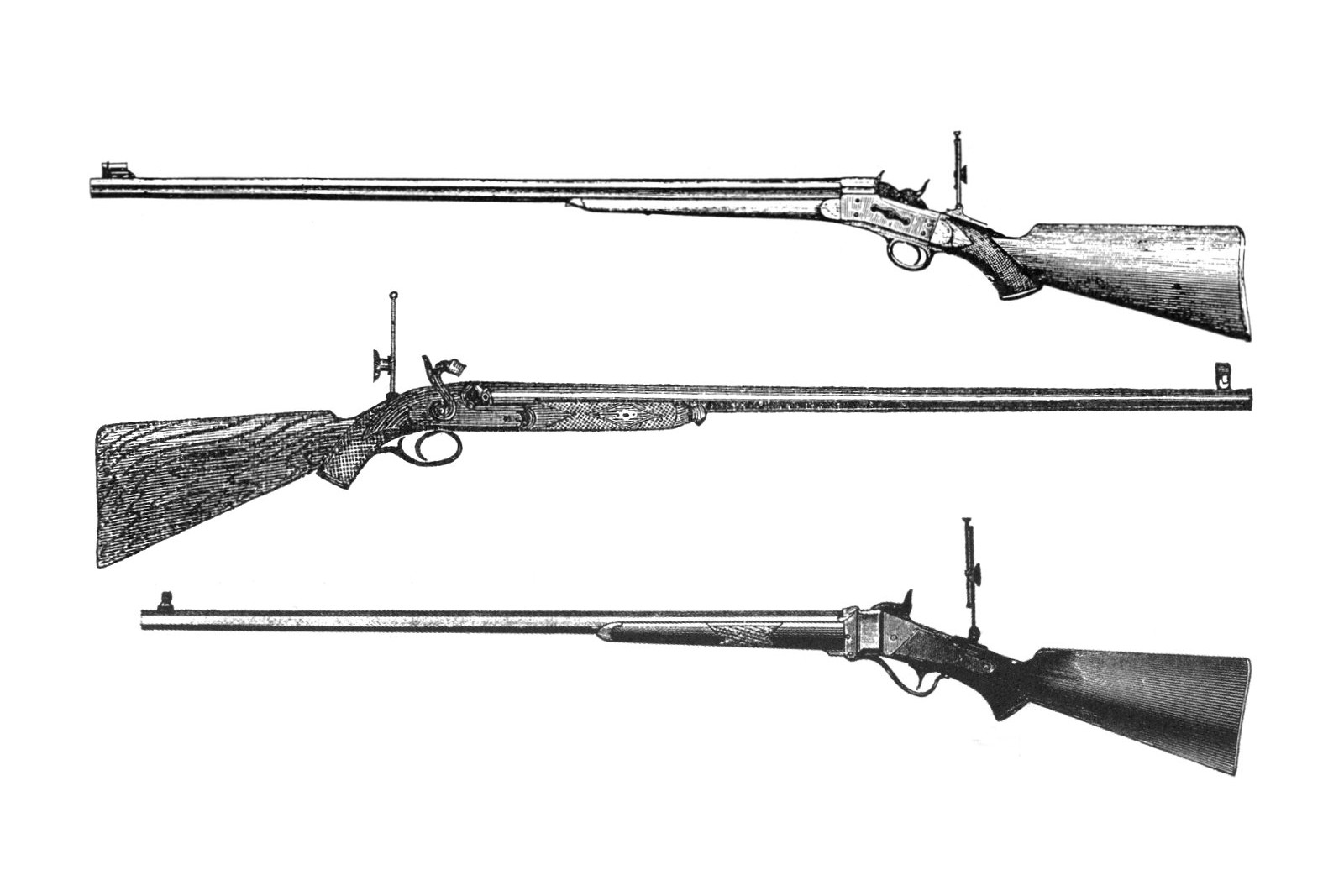You are here: Home > Firearms > Long Range Target Rifles
The first annual meeting of the National Rifle Association opened at Creedmoor on Wednesday, 8 October 1873.
The Sharpshooters’ Championship was “Open to all comers; any rifle within the rules of the Association; range, 800 and 1,000 yards; seven shots each distance; position, any.” The match was won by J.Adam (Canada Volunteers), using a Rigby muzzle-loading rifle. A Rigby was also used by the second placed competitor, A.J.Roux (22nd Regt. NY). In the remaining prize list competitors using the Remington Sporting rifle took the next three places, followed by a Metford, two Sharps and a further Metford.
A Forest & Stream reporter observed that “at the longer ranges the qualities of the finer rifles of course gave them greater advantages. This match also demonstrated the great improvement that had been made in breech-loaders. The score at 800 and 1,000 yards showed but little difference between the muzzle-loading Rigby and Metford rifles, and the breech-loading Remington, Sharpe, and Maynard.”
The report concluded with some wider observation on rifles, as follows:
Questions Of Arms
The great use of rifle range is that it must demonstrate whether an arm is good or not. Skill may have a great deal to do with the merit of a high score, but as the weapons used come into the hands of not only experts, but of second and third class shots the use of Creedmoor or any other range must determine the average excellence of any gun. The Remington rifle has been fully tested and has been found to be excellent, not only as a military but as a sporting rifle. In many of the matches, as may be seen on examining the scores, the Remington has held its own with the most delicately adjusted arms. Rifles like the Rigby and Metford have most carefully adjusted sights, where allowances are made for effects of wind blowing across the line of fire, &c. The use of all such adjustments are perfectly in order, and should be encouraged in every way. If a rifle as was remarked by Punch in speaking of the complicated arrangements of the Wimbledon expert, “had a steam engine at one end and a windmill at another,” so much the better, if in a range of a thousand yards, the marksman can improve his score a single figure. There is not then the least doubt that when the Remington rifles have adjusted to them these finer sights, that they will not only shoot quiet as well, but possibly out-shoot either the Rigby or Metford. In comparing it as a military arm with the arms used by either the English, French or German, we must declare that it is to be superior as to accuracy. Its penetration was also remarkable, shown by a shot passing through three feet of solid packed dirt, perforating a thick block of wood, and then falling spent with its shape still almost perfect. Subsequent general matches yet to come may bring in prominence some other rifle, when the Forest and Stream will be the first to assert its claims, but for the present, for all work, we are inclined to think that with a steady hand, and clear sight, whether the marksman be a soldier or a sportsman, the Remington has clearly proved itself the best arm of to-day. The Sharp rifle, especially in the press match, showed its excellence, and is a weapon of great merit. In judging of all rifle contests, our readers not familiar with the subject, should always bear in mind that a windy day always effects the shooting. In concluding our remarks on the first American rifle contest, we believe that the time will come when Creedmoor will be far too small for the concourse of people who will assemble from all parts of the Union, to witness this National pastime.
Forest & Stream, New York, USA – Thursday, 16 October 1873
The observations on the qualities of the American breech-loaders were to prove to be well founded. The following year, 1874, saw the first of the short series of international long range matches in which American riflemen with their breech-loading rifles dominated.
Quoted below is an extract from a letter by the Amateur Rifle Club (ARC) of New York seeking subscriptions in support of the US team to Ireland in 1875. It’s interesting contemporary comment on the lack of availability of American made rifles suitable, under the terms of the match, for long range shooting in 1873. It further underlines just how bold a move it was by the ARC to accept the original challenge from Ireland for long range competition.
“In November, 1873, the Irish team, whose success in winning the celebrated Elcho Shield at Wimbledon had constituted them the champions of Great Britain, published a challenge to American riflemen to shoot a match with American rifles against their celebrated Rigbys. Although the extreme distances, and the rules as to weapons and position were new to American marksmen, the Amateur Rifle Club, of this City, boldly accepted the challenge. Not only were they almost wholly inexperienced, but no rifles were made in America, which could compete, under the terms of the match, with those used by the Irish team. During the brief period which elapsed before the match, however, our manufacturers succeeded in providing them with the necessary weapons.”
New York Times, 31 January 1875
